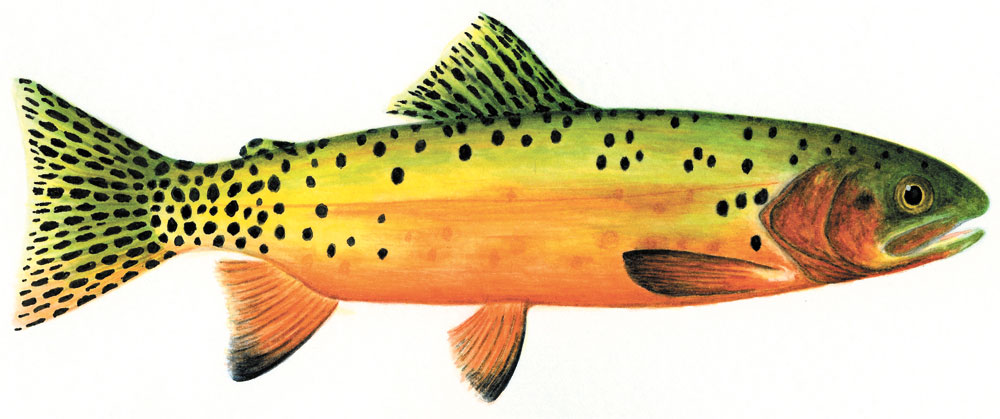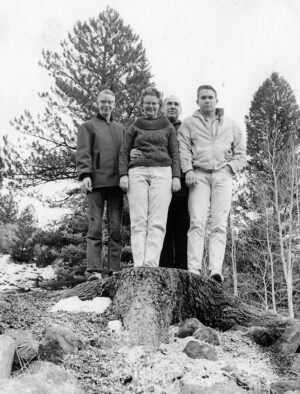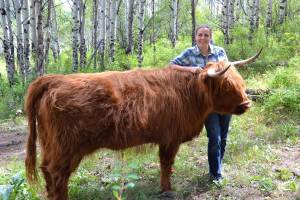By Tina Mitchell
As the Hayden Pass fire exploded in July, people and their beloved animals had to evacuate. Another group of local residents faced relocation as well. A rare subspecies of cutthroat trout protected by the Endangered Species Act lives in a three-mile stretch of the south prong of Hayden Creek – and even as humans were fleeing, Colorado Parks and Wildlife (CPW) staff were scrambling to create a plan to protect these fish.
Named for the slash of red below its jaw, the cutthroat trout’s historical distribution covered the broadest range of any stream-dwelling trout in the Western Hemisphere. The rugged topography of the species’ range isolated groups of cutthroats from each other, allowing the evolution of a whopping 14 distinct subspecies. Four closely related subspecies are native to Colorado: the Colorado River cutthroat, on the Western Slope; the Rio Grande cutthroat, in the San Luis Valley; the now-extinct yellowfin cutthroat; and the greenback cutthroat, the easternmost subspecies, found east of the Continental Divide.
Once widespread in the Arkansas and South Platte river drainages along the Front Range from Wyoming to New Mexico, the greenback cutthroat today occupies less than one percent of its historical range, due to mining (sediment and toxic run-off), agriculture (water diversions), and overfishing. The introduction of non-native species created problems as well: brown and brook trout outcompeted native greenbacks; and their close cousin, the rainbow trout, hybridized with them (hence, the cutbow trout). Even the introduction of different cutthroat subspecies diluted the greenback’s population through hybridization. Officially considered extinct by 1937, several wild groups of greenback cutthroat trout – purportedly – were found in the South Platte and Arkansas basins starting in the late 1950s. This discovery launched a reintroduction program, permitting this subspecies to be protected under the Endangered Species Act. Excitement for preserving these native beauties continued to build, culminating in the designation of the greenback cutthroat as Colorado’s state fish in 1994.
The greenback cutthroat trout today inhabits the cold, clear foothill and mountain waters of the Arkansas and South Platte rivers. Or so we thought. In 2012, though, extensive genetic work suggested that, in fact, the native cutthroat of the South Platte basin (and true heir to the name “greenback cutthroat trout”) existed only in a four-mile stretch of a single stream – Bear Creek, along the eastern flank of Pikes Peak. Most – if not all – of the fish released in the earlier reintroduction program were actually the similar-looking Colorado River and Rio Grande subspecies. Oops.
[InContentAdTwo] So how does the greenback cutthroat of Hayden Creek play into this confusing scenario? Greg Policky, an aquatic biologist with CPW, first found the fish in Hayden Creek in 1996. In 2003, CPW even built a barrier at the creek’s confluence to prevent other fish species from mingling with the Hayden Creek greenbacks. Following other reclamation efforts, this group of greenbacks became self-sustaining. But the unusual genetic make-up of this group remained unknown until 2012, when the DNA researched identified its differences from the Bear Creek greenback cutthroat trout. The only other fish with similar genetic makeup is a 1889 museum specimen from near Twin Lakes. No one knows for sure how the greenbacks ended up in Hayden Creek. Perhaps humans released them from another population at some point. Or they may have existed there undetected for thousands of years.
In wildfires, fish typically survive by swimming up- or downstream. However, rains following a massive fire can load streams with ash and sediment, killing the fish throughout the stream. (And indeed, rains deluged the Hayden Pass fire area in late August.) So on July 20, CPW staff temporarily moved more than 200 of these unique fish from Hayden Creek to two local fish hatcheries until any threats had passed. The rest of Hayden Creek’s estimated population of 1,200 greenbacks have been left to their own devices, Policky noted. “It could be bad, but we will just have to wait and see,” he said. The jury remains out.
John Muir stated, “When we try to pick out anything by itself, we find it hitched to everything else in the Universe.” Kudos and a huge vote of thanks to CPW for efforts to save these unique local residents before we all have to find out, through their disappearance, to what the Hayden Creek greenback cutthroat trout are hitched.
After a quarter-century in Colorado, Tina and her family recently migrated to Southern California, where she’ll spend the next quarter-century trying to remember that the mountains lie to the east.






